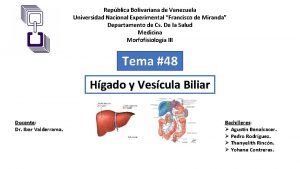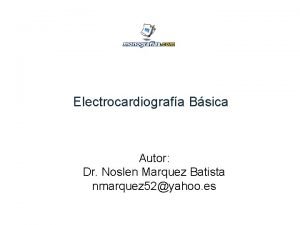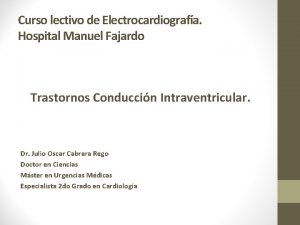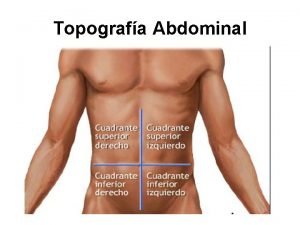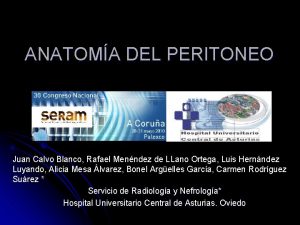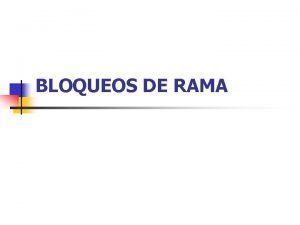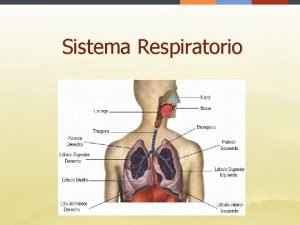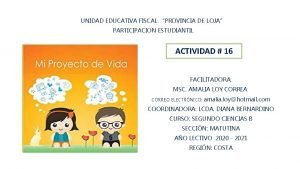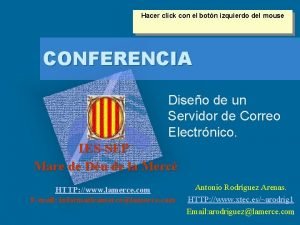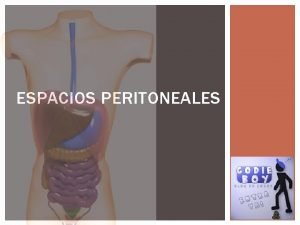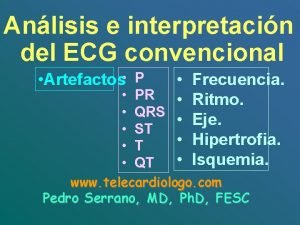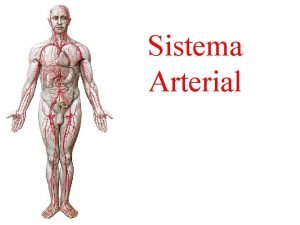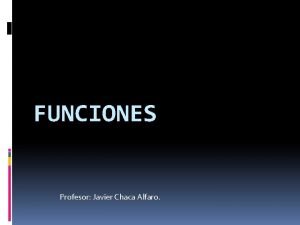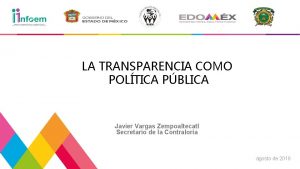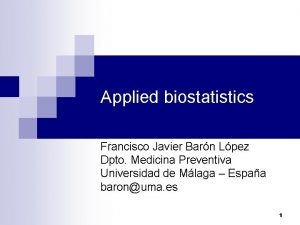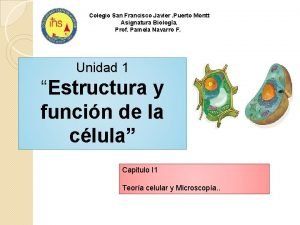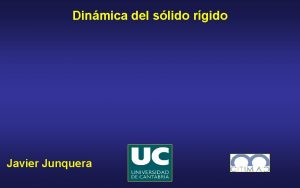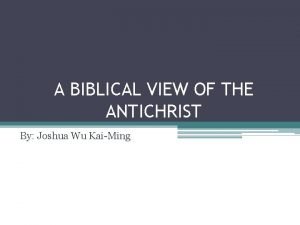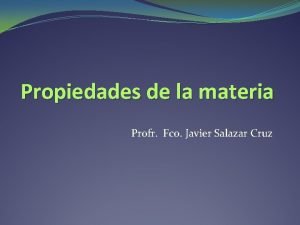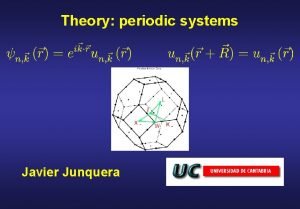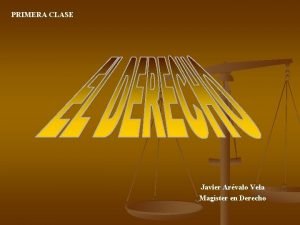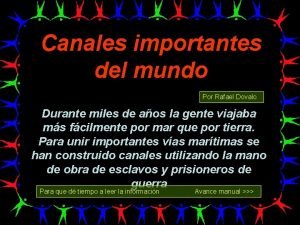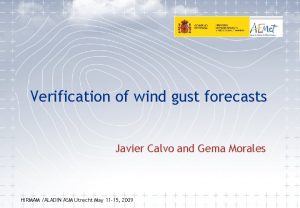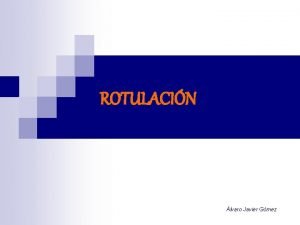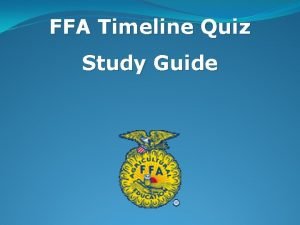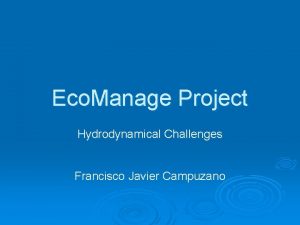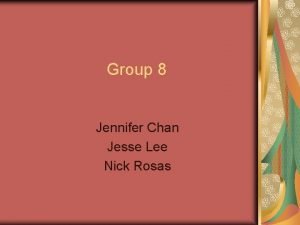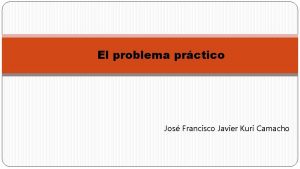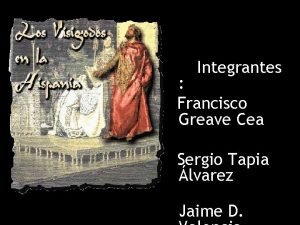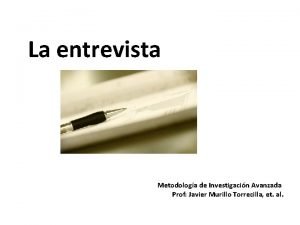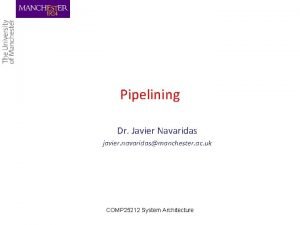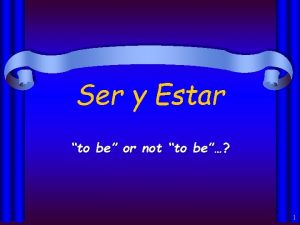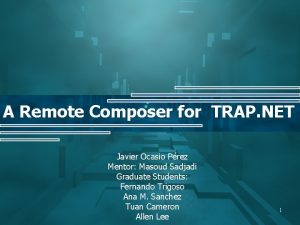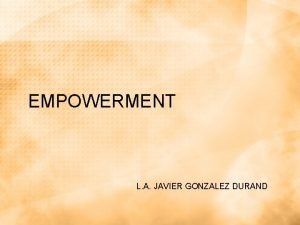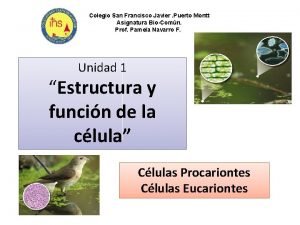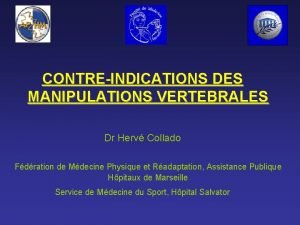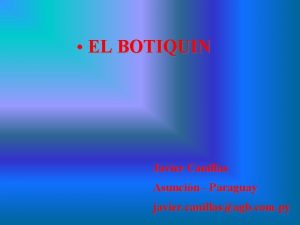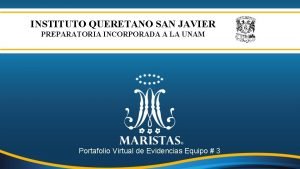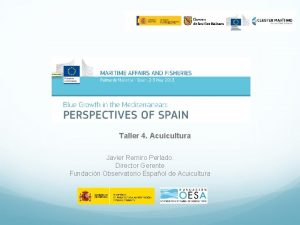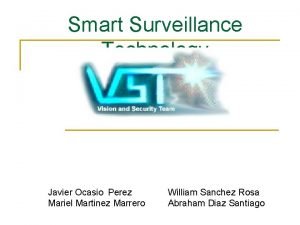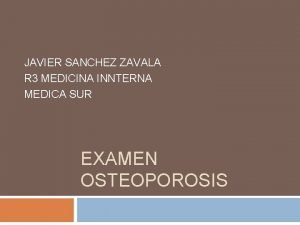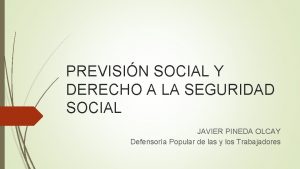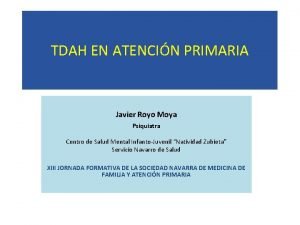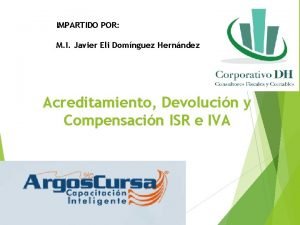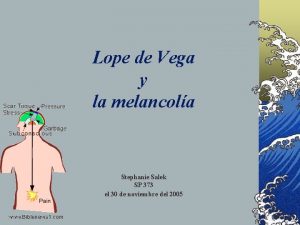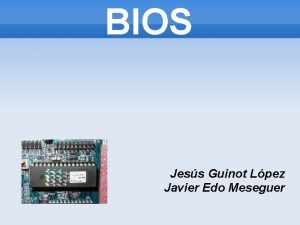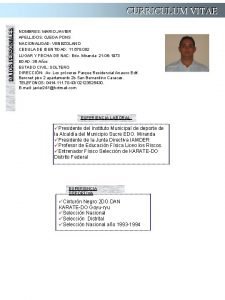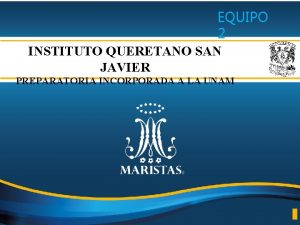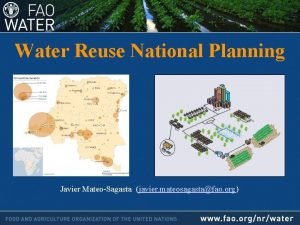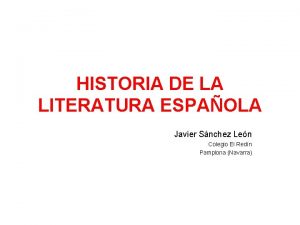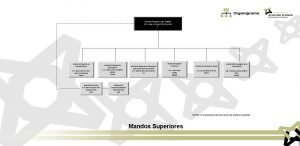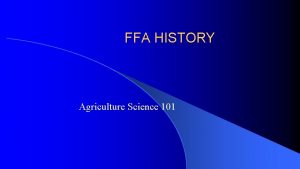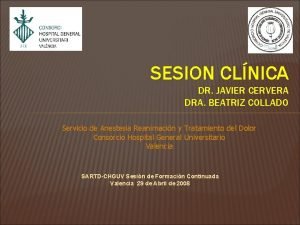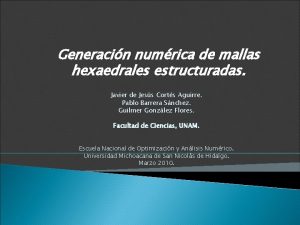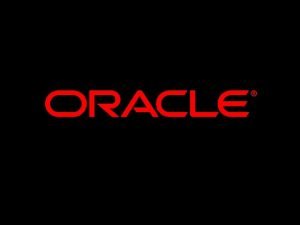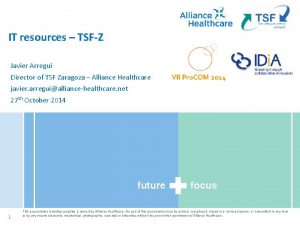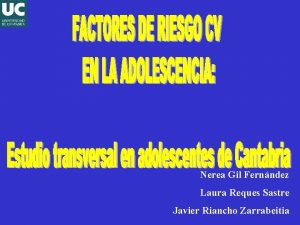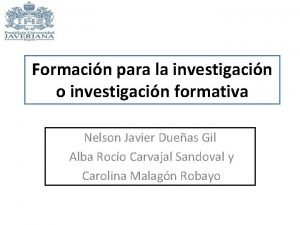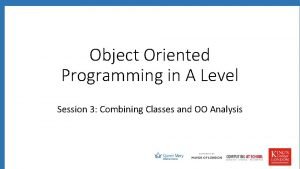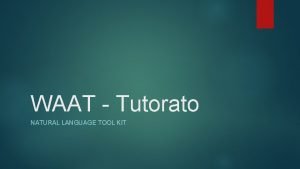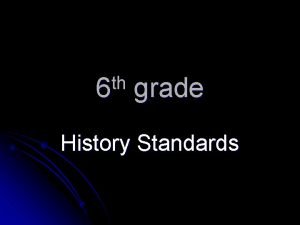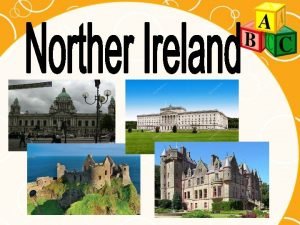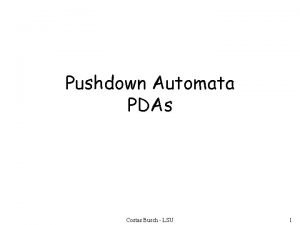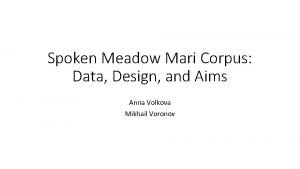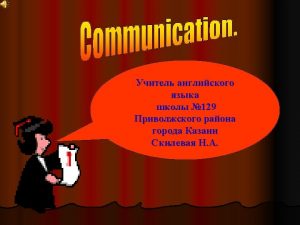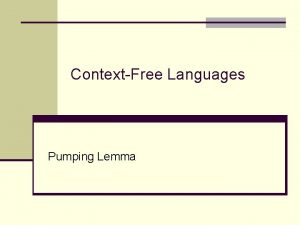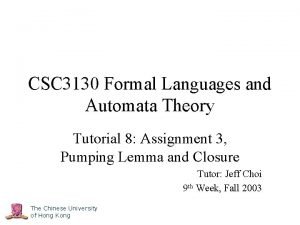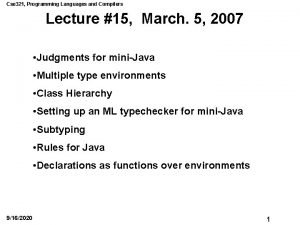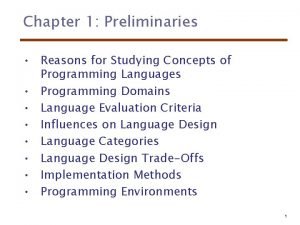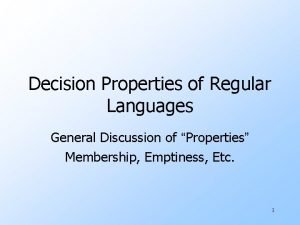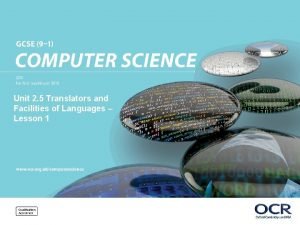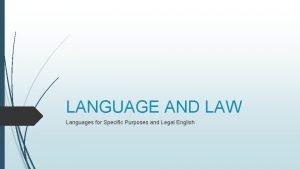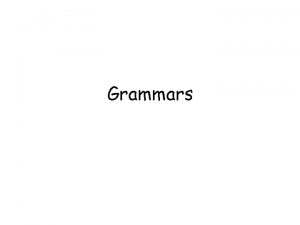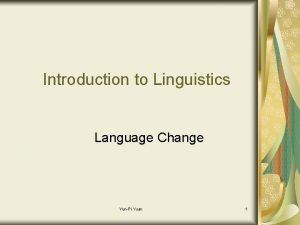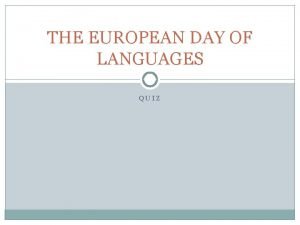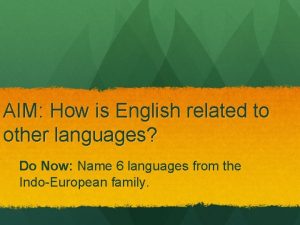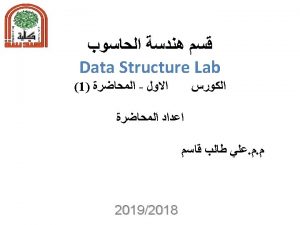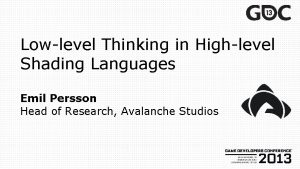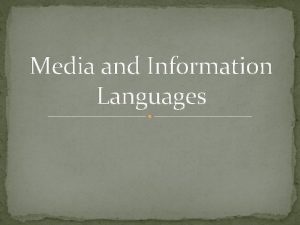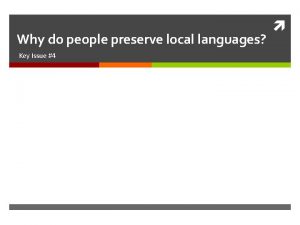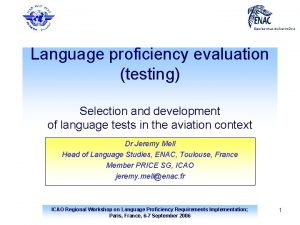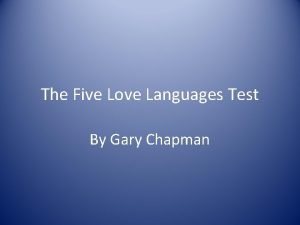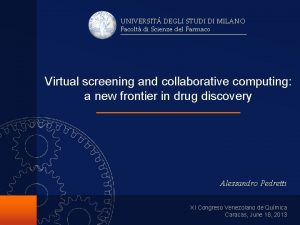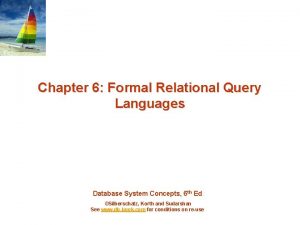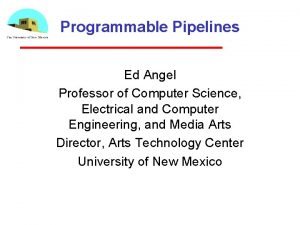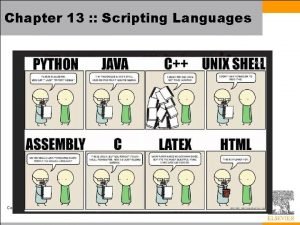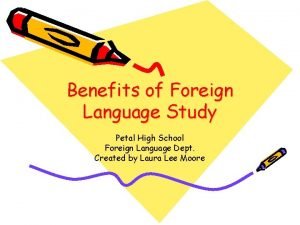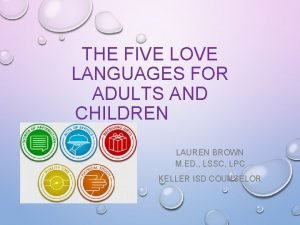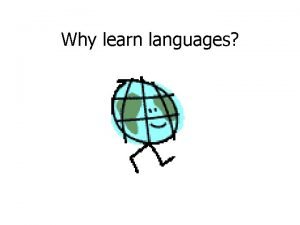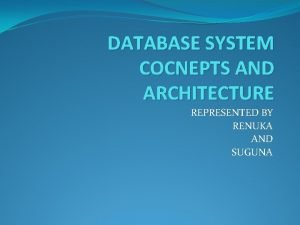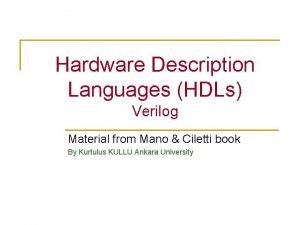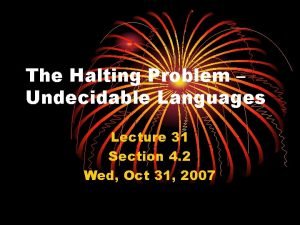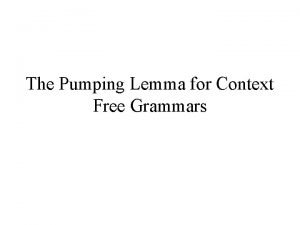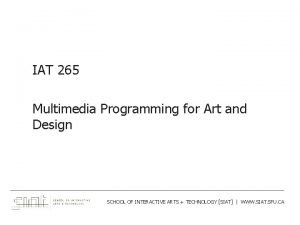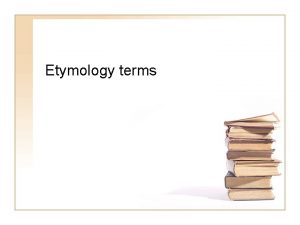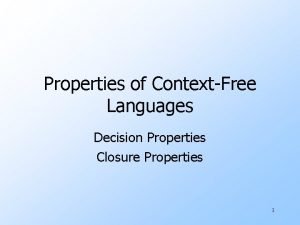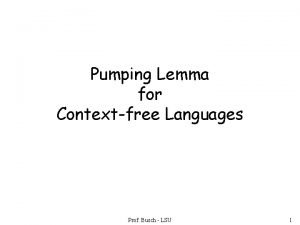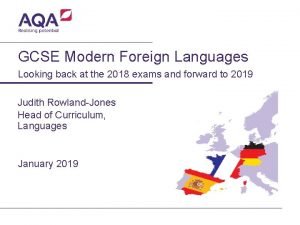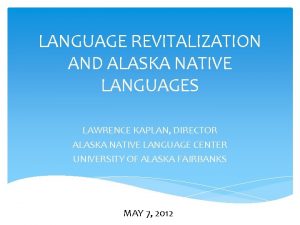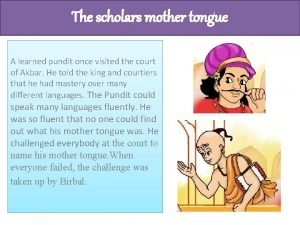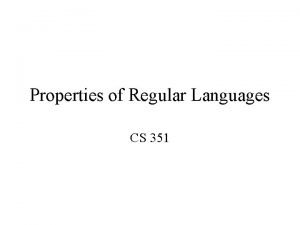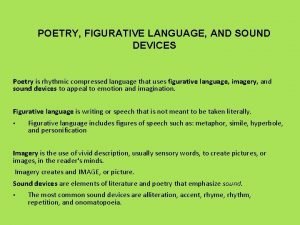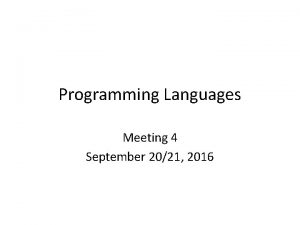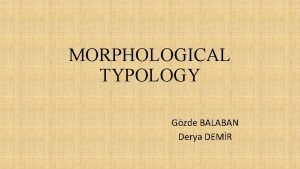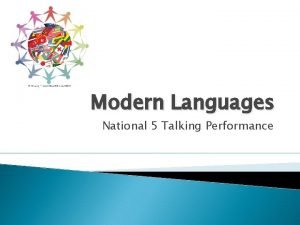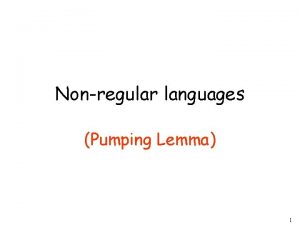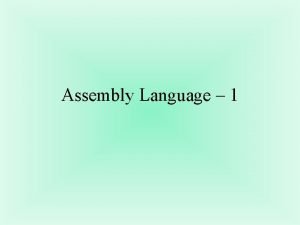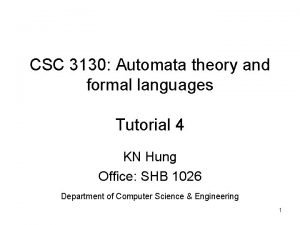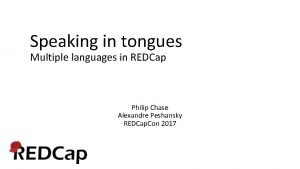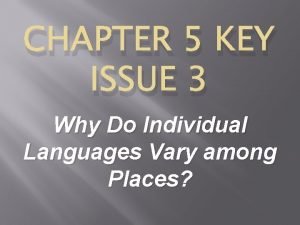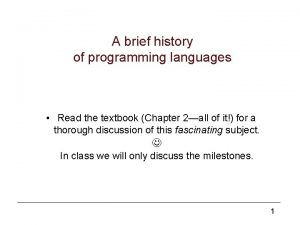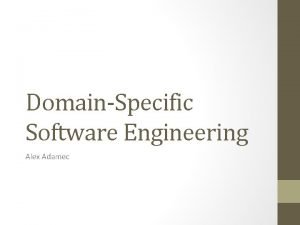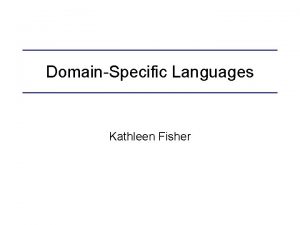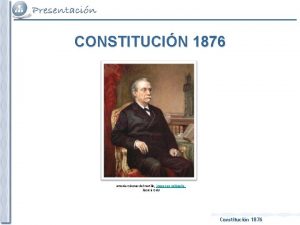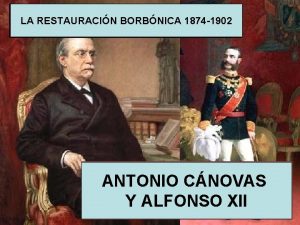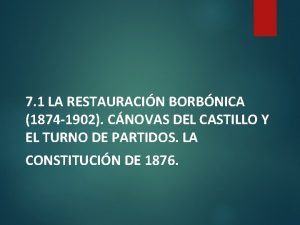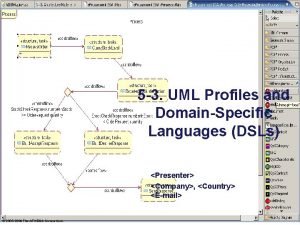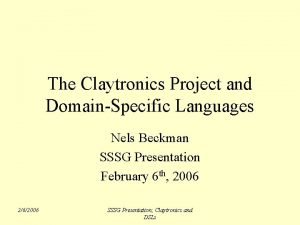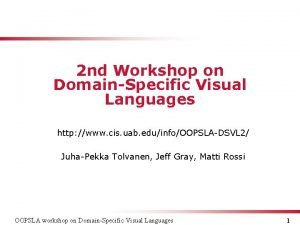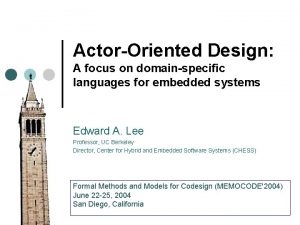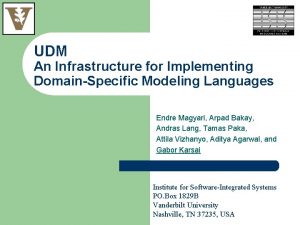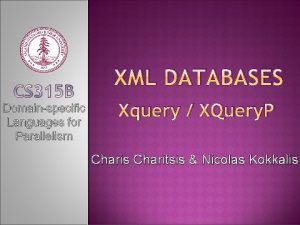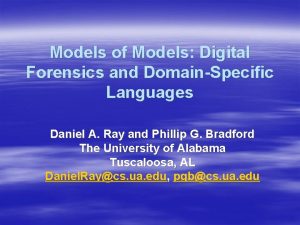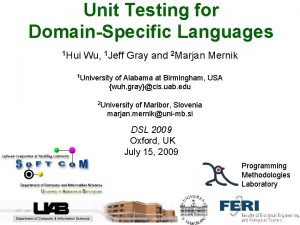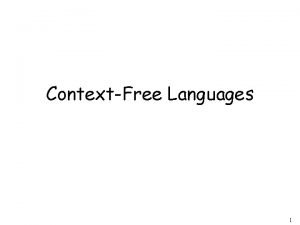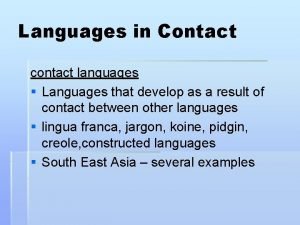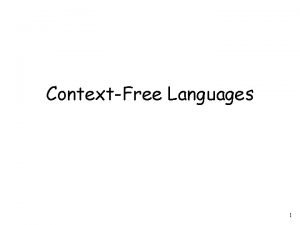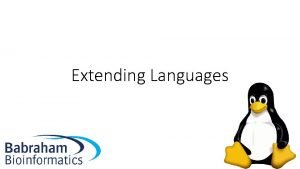Domainspecific Languages Javier Luis Cnovas Izquierdo javier canovasinria




















![GPLs • Java class Hello. World. App { public static void main(String[] args) { GPLs • Java class Hello. World. App { public static void main(String[] args) {](https://slidetodoc.com/presentation_image_h/1ae8b3c26135a81db9ba82244aadc6cf/image-21.jpg)







































































































































- Slides: 156

Domain-specific Languages Javier Luis Cánovas Izquierdo javier. canovas@inria. fr February 2013

Outline Languages Domain-Specific Languages Xtext GMF

Outline Languages Domain-Specific Languages Xtext GMF

What is a language

What is a language? From Wikipedia: Language is the human capacity for acquiring and using complex systems of communication, and a language is any specific example of such a system.

What is a language? From Wikipedia: Language is the human capacity for acquiring and using complex systems of communication, and a language is any specific example of such a system. Why? How?

What is a language? From Wikipedia: Language is the human capacity for acquiring and using complex systems of communication, and a language is any specific example of such a system. Why? How?

What is a language? From Wikipedia: Language is the human capacity for acquiring and using complex systems of communication, and a language is any specific example of such a system. Why? How?

What is a language? Table

What is a language? From the formal language theory: A language is a set of linguistic utterances, (i. e. , words), also called strings or sentences, which are composed by a set of symbols of an alphabet. A grammar is the set of structural rules that governs the composition of linguistic utterances

What is a language? From the formal language theory: A language is a set of linguistic utterances, (i. e. , words), also called strings or sentences, which are composed by a set of symbols of an alphabet. A grammar is the set of structural rules that governs the composition of linguistic utterances Why? How?

What is a language? From the formal language theory: A language is a set of linguistic utterances, (i. e. , words), also called strings or sentences, which are composed by a set of symbols of an alphabet. A grammar is the set of structural rules that governs the composition of linguistic utterances Why? How?

What is a language? From the formal language theory: A language is a set of linguistic utterances, (i. e. , words), also called strings or sentences, which are composed by a set of symbols of an alphabet. A grammar is the set of structural rules that governs the composition of linguistic utterances Why? How?

A grammar? machine. Definition: MACHINE OPEN_SEP state. List transition. List CLOSE_SEP; state. List: state (COMMA state)*; state: ID_STATE; transition. List: transition (COMMA transition)*; transition: ID_TRANSITION OPEN_SEP state CLOSE_SEP; MACHINE: ‘machine’; OPEN_SEP: ‘{’; CLOSE_SEP: ‘{’; COMMA: ‘, ’; ID_STATE: ‘S’ ID; ID_TRANSITION: ‘T’ (0. . 9)+; ID: (a. . z. A. . Z_) (a. . z. A. . Z 0. . 9)*; machine { SOne STwo T 1 { SOne STwo } } machine { S_first S_second T 1 { S_first S_second} T 1 { S_second S_first } } machine { SA SB SC SD T 1 { SA SD } T 2 { SA SB } T 3 { SB SC } T 4 { SB SA } }

Languages in engineering

Architecture

Cartography

Biology

Electronics

Languages in Computer Science
![GPLs Java class Hello World App public static void mainString args GPLs • Java class Hello. World. App { public static void main(String[] args) {](https://slidetodoc.com/presentation_image_h/1ae8b3c26135a81db9ba82244aadc6cf/image-21.jpg)
GPLs • Java class Hello. World. App { public static void main(String[] args) { System. out. println("Hello World!"); } } • C #include <stdio. h> int main(void) { printf("hello, worldn"); } • Python print("Hello world") • Delphi program Object. Pascal. Example; type THello. World = object procedure Put; end; var Hello. World: THello. World; procedure THello. World. Put; begin Write. Ln('Hello, World!'); end; begin New(Hello. World); Hello. World. Put; Dispose(Hello. World); end.

GPLs • UML

DSLs • SQL CREATE TABLE Employee ( id INT NOT NULL IDENTITY (1, 1) PRIMARY KEY, name VARCHAR(50), surname VARCHAR(50), address VARCHAR(255), city VARCHAR(60), telephone VARCHAR(15), ) • HTML <html> <head> <title>Example</title> </head> <body> <p>Example</p> </body> </html> • CSS body { text-align: left; font-family: helvetica, sans-serif; } h 1 { border: 1 px solid #b 4 b 9 bf; font-size: 35 px; } • La. Te. X ifthenelse{boolean{showcomments}} {newcommand{nb}[2]{ fcolorbox{gray}{yellow}{ bfseriessffamilyscriptsize#1 } {sfsmalltextit{#2}} } newcommand{version}{scriptsize$-$working$-$} } {newcommand{nb}[2]{} newcommand{version}{} }

DSLs • OCL employees->includes(#dent) self. questions->size self. employer->size self. employee->select (v | v. wages>10000 )->size Student. all. Instances ->for. All( p 1, p 2 | p 1 <> p 2 implies p 1. name <> p 2. name ) • ATL unique lazy rule custom. Func. Call { from src : Tuple. Type(class 1 : MM!EClass, class 2 : MM!EClass) to t : FOL!Custom. Func. Call( name <- src. class 1. name, declaration <- src. class 1, arguments <- Sequence{this. Module. variable(src)} ) } • Mini. UML package Courses { class Student { attribute studentid : number key attribute first. Name : string attribute last. Name : string } class Course { attribute name : string key attribute description : string optional attribute ects: number } }

GPLs vs DSLs

GPLs vs DSLs A GPL provides notations that are used to describe a computation in a human-readable form that can be translated into a machine-readable representation. A GPL is a formal notation that can be used to describe problem solutions in a precise manner. A GPL is a notation that can be used to write programs. A GPL is a notation for expressing computation. A GPL is a standardized communication technique for expressing instructions to a computer. It is a set of syntactic and semantic rules used to define computer programs.

GPLs vs DSLs The boundary isn’t as clear as it could be. Domain-specificity is not black-andwhite, but instead gradual: a language is more or less domain specific

GPLs vs DSLs The boundary isn’t as clear as it could be. Domain-specificity is not black-andwhite, but instead gradual: a language is more or less domain specific

Outline Languages Domain-Specific Languages Xtext GMF

DSL The big picture What is a DSL? Why? Anatomy Development Actors Best practices Worst practices

DSL The big picture What is a DSL? Why? Anatomy Development Actors Best practices Worst practices

The big picture Domain-Specific Languages?

Concepts

Concepts

Concepts

Concepts

DSL The big picture What is a DSL? Why? Anatomy Development Actors Best practices Worst practices

What is a DSL • In general: Language specially designed to perform a task in a certain domain

What is a DSL • In general: Language specially designed to perform a task in a certain domain • In the context of computer science: A formal processable language targeting at a specific viewpoint or aspect of a software system. It's semantics flexibility and notation is designed in order to support working with that viewpoint as good as possible

And the rest of languages? DSLs SQL, HTML C, Cobol Assembler Machine

Why DSLs? Abstraction Gap Assembler C, Java DSLs Problem Domain Solution Domain

What is offered? Higher abstraction s Avoid redundancy Separation of concerns Use domain concepts

What are the advantages? Productivity Platform Independent Quality Benefits No Overhead V&V Domain Expert Communication

What for? Architecture Utility • Generation of interfaces • Generation of WSDL • Set up of skeleton projects Full Technical Requirements Application Analysis Product Line

What for? Architecture Utility Full Architecture-Definition Languages Technical • • AUTOSAR Requirements Application Analysis Product Line

What for? Architecture • Model transformation languages: ATL, Acceleo • Constraints language: OCL Utility Full Technical Requirements Application Analysis Product Line

What for? Architecture Full Technical Utility Requirements Application • Describe a cooling algorithm in refrigerators • Configure hearing aids • Insurance mathematics Analysis Product Line

What for? Architecture Full Technical Utility Requirements Application • Analysis Pseudo-structured natural languages Product Line

What for? Architecture Full Technical Utility Requirements Application • Mathematical formalisms Product Line Analysis

What for? Architecture Full Technical Utility Requirements Application • Composition languages • Workflow languages Product Line Analysis

What is a domain? Inductive / Bottom-up • The domain is defined in terms of existing software used to address a particular class of problems or products • A domain D is identified as a set of programs with common characteristics or similar purpose • Often such domains do not exists outside the realm of software • Special case when we define a domain as a subset of programs written in a specific language (idiom) Deductive / top-down • The domain is defined as a body of knowledge about the real world, i. e. , outside the realm of software • A domain D is a body of knowledge for which we want to provide some form of software support • Much harder to address using DSLs because of the need to understand precisely the nature of the domain and identify interesting programs in such domain

but… how?

DSL The big picture What is a DSL? Why? Anatomy Development Actors Best practices Worst practices

Anatomy Concepts & relationships Wellformed Textual rules Graphical Abstract Concrete Syntax Denotational Pragmatic Translational Operational Semantics DSL

A first look Abstract Syntax • Describes the structure of the language and the way the different primitives can be combined together, independently of any particular representation or encoding. Concrete Syntax • Describes specific representations of the modeling language, covering encoding and/or visual appearance Semantics • Describing the meaning of the elements defined in the language and the meaning of the different ways of combining them.

A first look Abstract Syntax • Describes the structure of the language and the way the different primitives can be combined together, independently of any particular representation or encoding. Concrete Syntax • Describes specific representations of the modeling language, covering encoding and/or visual appearance Semantics • Describing the meaning of the elements defined in the language and the meaning of the different ways of combining them.

A first look Abstract Syntax • Describes the structure of the language and the way the different primitives can be combined together, independently of any particular representation or encoding. Concrete Syntax • Describes specific representations of the modeling language, covering encoding and/or visual appearance Semantics • Describing the meaning of the elements defined in the language and the meaning of the different ways of combining them. How this is executed?

Anatomy Concepts & relationships Wellformed Textual rules Graphical Abstract Concrete Syntax Denotational Pragmatic Translational Operational Semantics DSL

Abstract Syntax • Metamodelling techniques – UML notation • • • Concept => Class Property => Attribute Contaiment Relationship => Composite Association Relationship => Association Specialization => Inheritance Package => Package • Well-formed rules – OCL expressions context Transition inv: self. source <> self. target context Machine inv: self. states ->exists(s | s. ocl. Is. Kinf. Of(Initial. State))

Anatomy Concepts & relationships Wellformed Textual rules Graphical Abstract Concrete Syntax Denotational Pragmatic Translational Operational Semantics DSL

Concrete Syntax Textual Graphical

Concrete Syntax Textual

Concrete Syntax • Textual digraph Modernization { Start -> Extracting. Models; Extracting. Models -> MDD [label="C 2 M"]; MDD -> MDD [label="M 2 M"]; MDD -> System. Generation [label="M 2 C"]; System. Generation -> End; Start [shape=point, width=0. 2, label=""]; Extracting. Models [label="Extracting Models", shape=ellipse]; MDD [shape=ellipse]; System. Generation [label="System Generation", shape=ellipse]; End [shape=doublecircle, label="", width=0. 2, fillcolor=black, style=filled]; } • Graphical

Textual Syntax Grammar Metamodel conforms To Machine A conforms To Machine B Machine C Model A Model C Model B Grammarware Modelware

Textual Syntax Grammar Metamodel conforms To Machine A conforms To Machine B Machine C Model A Model C Model B Grammarware Modelware

Textual Syntax machine. Definition: MACHINE OPEN_SEP state. List transition. List CLOSE_SEP; state. List: state (COMMA state)*; state: ID_STATE; transition. List: transition (COMMA transition)*; transition: ID_TRANSITION OPEN_SEP state CLOSE_SEP; MACHINE: ‘machine’; OPEN_SEP: ‘{’; CLOSE_SEP: ‘{’; COMMA: ‘, ’; ID_STATE: ‘S’ ID; ID_TRANSITION: ‘T’ (0. . 9)+; ID: (a. . z. A. . Z_) (a. . z. A. . Z 0. . 9)*; conforms To machine { SOne STwo T 1 { SOne STwo } }

Textual Syntax machine. Definition: MACHINE OPEN_SEP state. List transition. List CLOSE_SEP; state. List: state (COMMA state)*; state: ID_STATE; transition. List: transition (COMMA transition)*; transition: ID_TRANSITION OPEN_SEP state CLOSE_SEP; MACHINE: ‘machine’; OPEN_SEP: ‘{’; CLOSE_SEP: ‘{’; COMMA: ‘, ’; ID_STATE: ‘S’ ID; ID_TRANSITION: ‘T’ (0. . 9)+; ID: (a. . z. A. . Z_) (a. . z. A. . Z 0. . 9)*; conforms To machine { SOne STwo T 1 { SOne STwo } }

You have already work with one package Courses { class Student { attribute studentid : number key attribute first. Name : string attribute last. Name : string } sintax of class Course { attribute name : string key attribute description : string optional attribute ects: number } conforms To } Ecore MM package Courses { class Student { attribute studentid : number key attribute first. Name : string attribute last. Name : string } class Course { attribute name : string key attribute description : string optional attribute ects: number } association Enrolment { end student : Student [1. . *] end course : Course [0. . *] } } conforms To sintax of

Textual Syntax • Grammar-oriented (Xtext) Grammar conforms To Graph B Metamodel conforms To Model A

Xtext • Model-Driven framework to develop textual DSLs • Is part of Eclipse Modeling Project • Is part of a DSL tooling initally called Open Architecture Ware • Main features: – – – Syntax Coloring Content Assist Validation and Quick Fixes Advanced Java Integration with other Eclipse tools

Textual Syntax • Metamodel-oriented (EMFText) Grammar conforms To Graph B Metamodel conforms To Model A

EMFText • Model-Driven framework to develop textual DSLs • Developed as a Eclipse plugin • Main features: – – Syntax Coloring Content Assist Validation and Quick Fixes Reference resolving mechanism

EMFText • Model-Driven framework to develop textual DSLs • Developed as a Eclipse plugin • Main features: – – Syntax Coloring Content Assist Validation and Quick Fixes Reference resolving mechanism

Graphical Syntax A draw is better than a long explanation digraph Modernization { Start -> Extracting. Models; Extracting. Models -> MDD [label="C 2 M"]; MDD -> MDD [label="M 2 M"]; MDD -> System. Generation [label="M 2 C"]; System. Generation -> End; Start [shape=point, width=0. 2, label=""]; Extracting. Models [label="Extracting Models", shape=ellipse]; MDD [shape=ellipse]; System. Generation [label="System Generation", shape=ellipse]; End [shape=doublecircle, label="", width=0. 2, fillcolor=black, style=filled]; }

GMF • Graphical Modeling Framework – Model-Driven Framework to develop graphical editors based on EMF and GEF – GMF is part of Eclipse Modeling Project – Provides a generative component to create the DSL tooling – Provides a runtime infrastructure to facilitate the development of graphical DSLs

Alternatives • GMF can be too complex • Eu. GENia – Automatically generated GMF infrastructure – Lowers the entrance barrier for creating GMF editors – Provides textual DSLs and wizards to define the graphical DSL • GMF simple mapping editor – Graphical DSL to configure GMF – Generators for creating the required GMF infrastructure

Graphical vs. Textual • Success depends on how the notation fits the domain class Person { private String name; } Person has (name, surname) Person name : string surname : string

Graphical vs. Textual • Success depends on how the notation fits the domain class Person { private String name; } Person has (name, surname) Person name : string surname : string • Graphical DSLs are not always easier to understand

Graphical vs. Textual • Expression of common concerns simple and concise class Person { private String name; } Person has (name, surname)

Graphical vs. Textual • Expression of common concerns simple and concise class Person { private String name; } Person has (name, surname) • Providing sensible defaults public class My. Class { public void read. Stream(Input. Stream stream, boolean close. Stream. Afer. Reading) {. . . } } public class My. Class { public void read. Stream(Input. Stream stream) { read. Stream(stream, true); } public void read. Stream(Input. Stream stream, boolean close. Stream. Afer. Reading) {. . . } }

Graphical vs. Textual • Verbosity for less common concerns Person has (name, surname) • Tool support and limitations – – – Syntax highlighting Outline Auto-completion Validation Layout … Person has (name, surname) extension name is String surname is String

Graphical AND Textual

Recommendations

Recommendations Semiotic clarity Cognitive Fit Graphic Economy Perceptual Discriminality Physics of notations Semantics transparency Complexity Management Dual Coding Visual Expressiveness Cognitive Integration

Recommendations There should be a 1: 1 correspondence between concepts and graphical symbols Semiotic clarity Cognitive Fit Graphic Economy Perceptual Discriminality Physics of notations Semantics transparency Complexity Management Dual Coding Visual Expressiveness Cognitive Integration

Recommendations Semiotic clarity Cognitive Fit Graphic Economy Perceptual Discriminality Physics of notations Semantics transparency Complexity Management Dual Coding Visual Expressiveness Cognitive Integration

Recommendations Semiotic clarity Cognitive Fit Graphic Economy Perceptual Discriminality Physics of notations Different symbols should be clearly distinguishable from each other Semantics transparency Complexity Management Dual Coding Visual Expressiveness Cognitive Integration

Recommendations Semiotic clarity Cognitive Fit Graphic Economy Perceptual Discriminality Physics of notations Semantics transparency Complexity Management Dual Coding Visual Expressiveness Cognitive Integration

Recommendations Semiotic clarity Cognitive Fit Graphic Economy Perceptual Discriminality Physics of notations Semantics transparency Use visual representations whose apprarance suggests their meaning Complexity Management Dual Coding Visual Expressiveness Cognitive Integration

Recommendations Semiotic clarity Cognitive Fit Graphic Economy Perceptual Discriminality Physics of notations Semantics transparency Complexity Management Dual Coding Visual Expressiveness Cognitive Integration Include mechanisms for dealing with complexity

Recommendations Semiotic clarity Cognitive Fit Graphic Economy Perceptual Discriminality Physics of notations Semantics transparency Complexity Management Dual Coding Visual Expressiveness Cognitive Integration Include explicit mechanisms to support integration of information from different diagrams

Recommendations Semiotic clarity Cognitive Fit Graphic Economy Perceptual Discriminality Physics of notations Semantics transparency Complexity Management Dual Coding Visual Expressiveness Cognitive Integration Use the full range and capacities of visual variables

Recommendations Semiotic clarity Cognitive Fit Graphic Economy Perceptual Discriminality Physics of notations Semantics transparency Complexity Management Dual Coding Visual Expressiveness Cognitive Integration

Recommendations Semiotic clarity Cognitive Fit Graphic Economy Perceptual Discriminality Physics of notations Semantics transparency Complexity Management Dual Coding Visual Expressiveness Cognitive Integration

Recommendations Semiotic clarity Cognitive Fit Graphic Economy Perceptual Discriminality Physics of notations Semantics transparency Complexity Management Dual Coding Visual Expressiveness Cognitive Integration

Recommendations Semiotic clarity Cognitive Fit Graphic Economy Perceptual Discriminality Physics of notations Semantics transparency Complexity Management Dual Coding Use text to complement graphics Visual Expressiveness Cognitive Integration

Recommendations Semiotic clarity Cognitive Fit Graphic Economy Perceptual Discriminality Physics of notations Semantics transparency Complexity Management Dual Coding Visual Expressiveness Cognitive Integration

Recommendations Semiotic clarity Cognitive Fit Graphic Economy The number of different graphical symbols should be cognitively manageable Perceptual Discriminality Physics of notations Semantics transparency Complexity Management Dual Coding Visual Expressiveness Cognitive Integration

Recommendations Use different visual dialects for different tasks and audiences Semiotic clarity Cognitive Fit Graphic Economy Perceptual Discriminality Physics of notations Semantics transparency Complexity Management Dual Coding Visual Expressiveness Cognitive Integration

Anatomy Concepts & relationships Wellformed Textual rules Graphical Abstract Concrete Syntax Denotational Pragmatic Translational Operational Semantics DSL

Semantics Denotational • Use of mathematical formalisms • Complex Pragmatic • Use of examples to illustrate the language • Input / outputs • Hard to deduce the real semantics Traslational • Translation to other well-known language • Similar to compilation Operational • Sequence of operations • Virtual machine

DSL The big picture What is a DSL? Why? Anatomy Development Actors Best practices Worst practices

Development process • Create a new one or reuse an existing one Decision • Enable non-technical users to participate Analysis Design • Problem domain identified • Domain knowledge gathered from end-users • Domain model: Scope, vocabulary, concepts, commonalities and variabilities • Define the DSL components (abstract and concrete syntaxes, semantics) • Decide best approach to implement the language • Develop DSL components (Xtext, EMFText, GMF, etc…) Implemen • If it is executable, develop the corresponding interpreter or compiler tation • Test the language Validation • Validate the language with the end-user

Regarding the implementation External DSL Grammar vs Internal Host Language conforms To Internal DSL 1 DSL Text Internal DSL 2

Internal DSL

External vs Internal External Complicated Limited Simple Adapted Flexible

DSL The big picture What is a DSL? Why? Anatomy Development Actors Best practices Worst practices

Actors

Actors Domain Knowledge High Low Technical Level High

DSL The big picture What is a DSL? Why? Anatomy Development Actors Best practices Worst practices

Best practices Limit Expressiveness Viewpoints Evolution Learn from GPLs Support Tooling

DSL The big picture What is a DSL? Why? Anatomy Development Actors Best practices Worst practices

Worst practices • Initial conditions – Only Gurus allowed • Believe that only gurus can build languages ir that “I’m smart and don’t need help” – Lack of Domain Understanding • Insufficiently understanding the problem domain or the solution domain – Analysis paralysis • Wanting the language to be theoretically complete, with its implementation assured

Worst practices • The source for Language Concepts – UML: New Wine in Old Wineskins • Extending a large, general-purpose modeling language – 3 GL Visual Programming • Duplicanting the concepts and semantics of traditional programming languages – Code: The Library is the Language • Focusing the language on the current code’s technical details – Tool: if you have a hammer • Letting the tool’s technical limitations dictate language development

Worst practices • The resulting language – Too Generic / Too Specific • Creating a language with a few generic concepts or too many specific concepts, or a language that can create only a few models – Misplaced Emphasis • Too strongly emphasizing a particular domain feature – Sacred at Birth • Viewing the initial language version as unalterable

Worst practices • Language Notation – Predetermined Paradigm • Choosing the wrong representational paradigm or the basis of a blinkered view – Simplistic Symbols • Using symbols that are too simple or similar or downright ugly

Worst practices • Language Use – Ignoring the use process • Failing to consider the language’s real-life usage – No training • Assuming everyone understands the language like its creator – Pre-adoption Stagnation • Letting the language stagnate after successful adoption

Outline Languages Domain-Specific Languages Xtext GMF

Xtext • Eclipse Project – Part of Eclipse Modeling – Part of Open Architecture Ware • Model-driven development of Textual DSLs • Part of a family of languages – Xtext – Xtend – Xbase – Xpand – Xcore

Eclipse Modeling Project

Eclipse Modeling Project

The grammar language • Corner-stone of Xtext • DSL to define textual languages – Describe the concrete syntax – Specify the mapping between concrete syntax and domain model • From the grammar, it is generated: – The domain model – The parser – The tooling

Main advantages • • • Consistent look and feel Textual DSLs are a resource in Eclipse Open editors can be extended Complete framework to develop DSLs Easy to connect to any Java-based language

Proposed development process Create Xtext Project Defining the DSL Grammar definition Workflow definition Configure Fomatting (opt) Configure Scoping (opt) Configure validation (opt) Configure generator Generate DSL tooling

Example DSL • Poll System application – Define a Poll with the corresponding questions – Each question has a text and a set of options – Each option has a text • Generate the application in different platforms DSL Tooling Poll System Definition Generator

Example DSL Tooling Generator

Grammar Definition Grammar definition

Grammar Definition Grammar reuse

Grammar Definition Derived metamodel

Parser Rules Grammar Definition

Keywords Grammar Definition

Grammar Definition Multivalue asignment Simple asignment ? = Boolean asignment

Grammar Definition Cardinality (others: * ? )

Grammar Definition Containment

Grammar Definition

Grammar Definition

Grammar Definition

Grammar Definition

Xtext Demo

Outline Languages Domain-Specific Languages Xtext GMF

GMF • Eclipse project – Eclipse Modelling components – Uses • EMF (Eclipse Modeling Framework) • GEF (Graphical Editing Framework) • Model-driven framework for Graphical DSLs – Everything is a model • Still under development (perpetual beta) • The only alternative for now • DSL definition easy, tweaking hard

Eclipse Modeling Project

Eclipse Modeling Project

Parts of GMF • Tooling – Editors for notation, semantic and tooling – GMF Dashboard – Generator to produce the DSL implementation • Runtime – Generated DSLs depend on the GMF Runtime to produce an extensible graphical editor

Main advantages • • Consistent look and feel Diagram persistence Open editors can be extended by third-parties Already integrated with various Eclipse components • Extensible notation metamodel to enable the isolation of notation from semantic concerns • Future community enhancements will easily be integrated

Proposed development process Create GMF Project Defining the DSL Domain Model Graphical Definition Tooling Definition Develop Mapping Model Create Generator Model Generate Diagram Plugin

Proposed development process

Defining a graphical DSL Domain Graphical Tooling Definition Model Mapping Model

Example DSL

Domain Model • Concepts – Poll. System – Poll – Question – Option • Attributes – A Poll has a name – A Question has an identifier and a descriptive text – An Option has an identifier and a descriptive text • Relationships – Poll. System is composed of polls and questions – Question has a set of options

Graphical Definition • Defines the graphical representation of the DSL elements • Tree-based editor • Main elements – – – Node DSL node Connector DSL link Compartment Node compartment (for complex nodes) Label The label of a Node, Connector or compartment Figure descriptor Graphical representation of a Node • • Rectangle, ellipse, polygon, … Polyline, … Decorators, icons, … Custom figures, … • Provides simple figures that they can be customized

Graphical Definition • • A model will represent a Poll. System A Poll will be a node A Question will be a rectangular node An Option will be a rectangular node included in the Question node

Tooling Definition • Defines the tooling to create the DSL elements in the editor • Tree-based editor • Main elements – Tool Group Set of tools – Creation Tool for creating a DSL element (node, connector, etc, …) • Each tool can have an icon and a contextual help

Mapping Model • Defines the correspondeces between model elements, graphical elements and tooling elements • Automatically generated (at least a kick-off version) • Tree-based editor • Main elements – Top Node Reference Maps a concept of the root model element – Node Mapping Maps a concept with the graphical node and tooling – Feature Label Mapping Maps a concept attribute with the graphical label – Child Reference Maps a containment reference with the compartment – Compartment Mapping Maps a concet with the graphical node – Link Mapping Maps a reference of the root model elements

GMF Demo

References 1. 2. 3. 4. 5. 6. 7. 8. 9. 10. 11. 12. 13. 14. 15. 16. 17. Kleppe, A. : Software Language Engineering J. Bézivin, “Model Driven Engineering: An Emerging Technical Space, ” in GTTSE conf. , 2006, vol. 4143, pp. 36– 64 M. Brambilla, J. Cabot, M. Wimmer. “Model-Driven Software Engineering in Practice”. Morgan & Claypool M. Mernik, J. Heering, and A. M. Sloane, “When and how to develop domain-specific languages, ” ACM Computing Surveys, vol. 37, no. 4, pp. 316– 344, Dec. 2005. Brambilla, M. , Cabot, J. , Wimmer, M. : Model-Driven Software Engineering in Practice Y. Sun and Z. Demirezen, “Is My DSL a Modeling or Programming Language? , ” in DSPD conf. , 2008. M. Strembeck and U. Zdun, “An approach for the systematic development of domain specific languages, ” Software: Practice and Experience, vol. 39, pp. 1253– 1292, 2009. J. -M. Favre, “Foundations of Meta-Pyramids : Languages vs. Metamodels, ” pp. 1– 28. J. De Lara and E. Guerra, “Languages for Model Driven Engineering, ” in ECMDA conf. , 2012, vol. 7349, pp. 259– 274. D. L. Moody, “The ‘physics’ of notations: Toward a scientific basis for constructing visual notations in software engineering, ” Software Engineering, IEEE Transactions on, vol. 35, no. 6, pp. 756– 779, Nov. 2009. D. L. Moody and J. Van Hillegersberg, “Evaluating the visual syntax of UML: An analysis of the cognitive effectiveness of the UML family of diagrams, ” in SLE conf. , 2009, vol. 5452, no. Figure 1, pp. 16– 34. M. Völter, “MD */ DSL Best Practices Update March 2011, ” 2011. S. Kelly and R. Pohjonen, “Worst practices for domain-specific modeling, ” IEEE Software, vol. 26, no. 4, pp. 22– 29, 2009. M. Völter, “DSL Engineering. Designing, Implementing and Using Domain-Specific Languages”. I. Kurtev, J. Bézivin, and M. Aksit, “Technological Spaces an Initial Appraisal, ” in DOA, 2002, pp. 1– 6. Xtext Reference Guide GMF documentation
 Vesicula biliar histologia
Vesicula biliar histologia P mellada en ecg
P mellada en ecg Canino inferior cara labial
Canino inferior cara labial Posición cefálica dorso derecho
Posición cefálica dorso derecho Norma pimentel izquierdo
Norma pimentel izquierdo Hemibloqueo posterior izquierdo
Hemibloqueo posterior izquierdo Flanco derecho órganos
Flanco derecho órganos Espacios perihepaticos
Espacios perihepaticos Material visual representacional
Material visual representacional Bloqueo de rama derecha
Bloqueo de rama derecha Bronquio principal derecho
Bronquio principal derecho Llena la tabla adjunta de la siguiente manera:
Llena la tabla adjunta de la siguiente manera: Izquierdo intranet
Izquierdo intranet Gastrohepatico
Gastrohepatico Cuadritos ecg
Cuadritos ecg Diferencia entre arterias y venas
Diferencia entre arterias y venas Javier peralta calvillo
Javier peralta calvillo Cual es el dominio
Cual es el dominio Javier arvalo
Javier arvalo Javier vargas zempoaltecatl
Javier vargas zempoaltecatl Javier edo meseguer
Javier edo meseguer Colegio san francisco javier
Colegio san francisco javier Javier pilar
Javier pilar Javier junquera
Javier junquera Javier arzuaga
Javier arzuaga Jared kushner antichrist
Jared kushner antichrist Capacidad de la materia para fragmentarse
Capacidad de la materia para fragmentarse Javier junquera
Javier junquera Arvalo
Arvalo Javier dovalo
Javier dovalo Javier calvo height
Javier calvo height Tipo de letras
Tipo de letras Ffa 1969
Ffa 1969 Dr javier sevilla
Dr javier sevilla Dr javier campuzano
Dr javier campuzano Javier gilabert
Javier gilabert Jesse lee apartments
Jesse lee apartments Bitsdev
Bitsdev Dr. francisco javier kuri con
Dr. francisco javier kuri con Francisco javier tapia greave
Francisco javier tapia greave Javier navaridas
Javier navaridas Que es comorbilidad ejemplos
Que es comorbilidad ejemplos Javier otazu ojer
Javier otazu ojer Características de una entrevista
Características de una entrevista 5 why washington monument
5 why washington monument Javier navaridas
Javier navaridas Javier cansado enfermo
Javier cansado enfermo Javier gustavo oyarse cruz
Javier gustavo oyarse cruz Dr. javier e. calvo
Dr. javier e. calvo Javier ocasio perez
Javier ocasio perez Francisco javier robles de mendoza
Francisco javier robles de mendoza Caracteristicas del empowerment
Caracteristicas del empowerment Cuál es la función del aparato de golgi
Cuál es la función del aparato de golgi Escuela secundaria tecnica 60
Escuela secundaria tecnica 60 Javier cervera dentiste
Javier cervera dentiste Javier junquera
Javier junquera Javier luque di salvo
Javier luque di salvo Javier hourcade bellocq
Javier hourcade bellocq Javier canillas
Javier canillas Instituto queretano san javier
Instituto queretano san javier Javier remiro
Javier remiro Javier ocasio perez
Javier ocasio perez Domingo xviii tiempo ordinario ciclo b
Domingo xviii tiempo ordinario ciclo b Juan javier sanchez zavala
Juan javier sanchez zavala Previsin
Previsin Javier royo psiquiatra
Javier royo psiquiatra Javier eli dominguez hernandez
Javier eli dominguez hernandez Imagenes de javier cupido es un murcielago
Imagenes de javier cupido es un murcielago Javier salek
Javier salek Javier
Javier Javier edo meseguer
Javier edo meseguer Mario javier ojeda hernandez
Mario javier ojeda hernandez Velliga
Velliga Instituto queretano san javier
Instituto queretano san javier Javier mateo-sagasta
Javier mateo-sagasta Ayer naciste y moriras mañana
Ayer naciste y moriras mañana Francisco javier salazar silva
Francisco javier salazar silva Ffa fun facts
Ffa fun facts Dr. javier collado
Dr. javier collado Javier de jesús cortés aguirre
Javier de jesús cortés aguirre Javier royo moya
Javier royo moya Dr javier barrera
Dr javier barrera Domingo 30 del tiempo ordinario ciclo b
Domingo 30 del tiempo ordinario ciclo b Javier arregui
Javier arregui Nerea gil
Nerea gil Nelson javier duenas gil
Nelson javier duenas gil Languages 5e
Languages 5e Language
Language Languages canada
Languages canada Thread dalam java
Thread dalam java Northern ireland official languages
Northern ireland official languages Languages accepted by pda
Languages accepted by pda New zealand official languages english
New zealand official languages english Uralic languages
Uralic languages Rogerfederer.com
Rogerfederer.com Tiny programming language
Tiny programming language How many languages are there
How many languages are there Imperative programming languages
Imperative programming languages Pumping lemma for cfls
Pumping lemma for cfls Automata theory tutorial
Automata theory tutorial Programming languages
Programming languages Controlled languages
Controlled languages Csci3130
Csci3130 Reasons for studying concepts of programming languages
Reasons for studying concepts of programming languages Decision properties of regular languages
Decision properties of regular languages Mango mission statement
Mango mission statement Translators and facilities of languages
Translators and facilities of languages Languages for specific purposes
Languages for specific purposes Linear grammar
Linear grammar Polysynthetic language
Polysynthetic language European day of languages quiz
European day of languages quiz Properties of regular languages
Properties of regular languages Balto slavic languages
Balto slavic languages Middle level programming languages
Middle level programming languages Rcp hlsl
Rcp hlsl Importance of media and information languages
Importance of media and information languages Key issue 4: why do people preserve local languages?
Key issue 4: why do people preserve local languages? Languages known in resume
Languages known in resume Gary chapman love languages test
Gary chapman love languages test Types of languages
Types of languages Real-time systems and programming languages
Real-time systems and programming languages Formal relational query languages
Formal relational query languages Languages 5e
Languages 5e Innovative features of scripting language
Innovative features of scripting language Petal in other languages
Petal in other languages Standard language definition ap human geography
Standard language definition ap human geography Love language example
Love language example Language
Language Languages
Languages Database languages
Database languages Verilog
Verilog Turing unrecognizable languages
Turing unrecognizable languages Pumping lemma for context-free languages examples
Pumping lemma for context-free languages examples Regular grammars generate regular languages.
Regular grammars generate regular languages. Multimedia programming languages
Multimedia programming languages Fisker frits fisker friske fisk
Fisker frits fisker friske fisk Euphemism etymology
Euphemism etymology Closure properties of context free languages
Closure properties of context free languages Lsu languages
Lsu languages Gcse modern foreign languages
Gcse modern foreign languages Thank you in alaska native languages
Thank you in alaska native languages Love language test
Love language test What did the pundit challenge the courtiers with
What did the pundit challenge the courtiers with Decision properties of regular languages
Decision properties of regular languages Right linear grammar
Right linear grammar Poems with sound devices and figurative language
Poems with sound devices and figurative language Languages 2021
Languages 2021 Gözde balaban
Gözde balaban National 5 modern languages talking performance
National 5 modern languages talking performance Victorian school of languages
Victorian school of languages Pumping lemma non regular languages examples
Pumping lemma non regular languages examples Assembly languages list
Assembly languages list Uga travel authority
Uga travel authority Cyk algo
Cyk algo Redcap multiple languages
Redcap multiple languages Key issue 3: why do individual languages vary among places?
Key issue 3: why do individual languages vary among places? Brief history of programming languages
Brief history of programming languages
